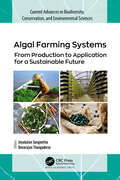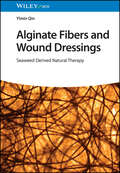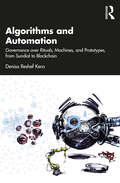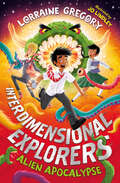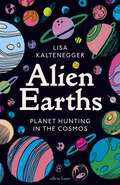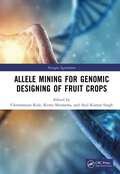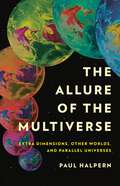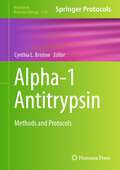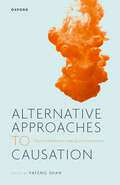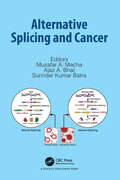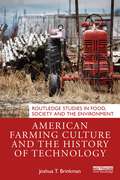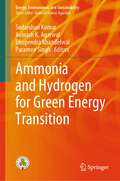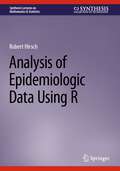- Table View
- List View
Algal Farming Systems: From Production to Application for a Sustainable Future (Current Advances in Biodiversity, Conservation, and Environmental Sciences)
The farming and cultivation of algae can provide sustainable solutions for issues like food security-related problems, costly health-related products, sustainable fuels, and more. However, the use of algae is currently restricted to high-value, low-volume markets, mainly due to the high investment and production costs involved. In recent years, algaculture for food and fuel purposes has begun a transition from R&D and pilot-scale operations to commercial-scale systems. This new book presents the latest technological innovations in algae production, market status, and prospects for algal applications.The book provides an informative overview of different perspectives on the commercial production of algae-based food, health, and high-value cosmeceutical products, providing an institutional framework to support and promote the development and commercialization of algal farming. The book discusses phycotechnology and highlights the current trends and future scope of algal technology. It also presents new information on algal culture conditions and cultivation strategies, including a look at geographic position and local climate as key factors in the implementation of microalgae-based processes. Algal production, marketing strategies, and their commercialization are discussed, as are the industrial applications of algae, focusing mainly on nutraceutical, pharmaceutical, and cosmeceutical applications of microalgae and macroalgae.
Alginate Fibers and Wound Dressings: Seaweed Derived Natural Therapy
by Yimin QinAlginate Fibers and Wound Dressings Comprehensive resource on the science and research behind alginate fibers, along with their many functional applications in different fields Alginate Fibers and Wound Dressings: Seaweed Derived Natural Therapy offers a general introduction to the sources of alginate and the production methods for alginate fibers and wound dressings, in addition to the novel properties and applications of these functional materials in wound management. Taking into consideration of the latest results of clinical researches conducted around the world, this book summarizes the unique properties of alginate wound dressings, including their ‘gel blocking’ properties and the ability to promote wound healing, facilitate haemostasis, reduce pain, suppress bacteria growth, and lower treatment cost in the treatment of a wide range of wounds, including leg ulcers, burn wounds, pressure sores, surgical wounds, and many other types of wounds with high levels of exudates. Sample topics covered in Alginate Fibers and Wound Dressings include: Why alginate fibers can be used as a carrier to deliver zinc, copper, silver, and other bioactive metal ions How alginate wound dressings can help maintain a physiologically moist microenvironment that promotes healing and the formation of granulation tissue Unique properties of alginate fibers that are highly useful for functional textile materials and medical textile products, such as gel forming properties when in contact with body fluid Other excellent performance characteristics of alginate fibers, such as haemostatic, antimicrobial, skin whitening, and many other unique bioactivities Providing comprehensive coverage of the subject, Alginate Fibers and Wound Dressings is an essential resource for students, researchers, and professionals involved in professions and programs of study that intersect with the subject.
Alginate Fibers and Wound Dressings: Seaweed Derived Natural Therapy
by Yimin QinAlginate Fibers and Wound Dressings Comprehensive resource on the science and research behind alginate fibers, along with their many functional applications in different fields Alginate Fibers and Wound Dressings: Seaweed Derived Natural Therapy offers a general introduction to the sources of alginate and the production methods for alginate fibers and wound dressings, in addition to the novel properties and applications of these functional materials in wound management. Taking into consideration of the latest results of clinical researches conducted around the world, this book summarizes the unique properties of alginate wound dressings, including their ‘gel blocking’ properties and the ability to promote wound healing, facilitate haemostasis, reduce pain, suppress bacteria growth, and lower treatment cost in the treatment of a wide range of wounds, including leg ulcers, burn wounds, pressure sores, surgical wounds, and many other types of wounds with high levels of exudates. Sample topics covered in Alginate Fibers and Wound Dressings include: Why alginate fibers can be used as a carrier to deliver zinc, copper, silver, and other bioactive metal ions How alginate wound dressings can help maintain a physiologically moist microenvironment that promotes healing and the formation of granulation tissue Unique properties of alginate fibers that are highly useful for functional textile materials and medical textile products, such as gel forming properties when in contact with body fluid Other excellent performance characteristics of alginate fibers, such as haemostatic, antimicrobial, skin whitening, and many other unique bioactivities Providing comprehensive coverage of the subject, Alginate Fibers and Wound Dressings is an essential resource for students, researchers, and professionals involved in professions and programs of study that intersect with the subject.
Algorithms and Automation: Governance over Rituals, Machines, and Prototypes, from Sundial to Blockchain
by Denisa Reshef KeraTo enact the book’s central theme of automation and human agency, the author designed a Bot trained on her book to support dialogue with the content and facilitate discussions. If you like to compare what the author says and Bot ‘interprets’ or generates, go here https://www.anonette.net/denisaBot/ Algorithms and Automation: Governance over Rituals, Machines, and Prototypes, from Sundial to Blockchain is a critical examination of the history and impact of automation on society. It provides thought-provoking perspectives on the history of automation and its relationship with power, emphasizing the importance of considering the social context in which automation is developed and used. The book argues that automation has always been a political and social force that shapes our lives and futures, rather than a neutral tool. The author provides a genealogy of automation, tracing its development from ancient rituals to modern-day prototypes, and highlights the challenges posed by new technologies such as blockchain and artificial intelligence. The volume argues that we need more democratic and accountable governance over technological innovation to ensure that it respects human rights, political pluralism, legitimacy, and other values we hold dear in our institutions and political processes. An engaging read on a fascinating topic, this book will be indispensable for scholars, students, and researchers of science and technology studies, digital humanities, politics and governance, public policy, social policy, system design and automation, and history and philosophy of science and technology. It will also be of interest to readers interested in the interactions of the sciences and the social sciences and humanities.
Algorithms and Automation: Governance over Rituals, Machines, and Prototypes, from Sundial to Blockchain
by Denisa Reshef KeraTo enact the book’s central theme of automation and human agency, the author designed a Bot trained on her book to support dialogue with the content and facilitate discussions. If you like to compare what the author says and Bot ‘interprets’ or generates, go here https://www.anonette.net/denisaBot/ Algorithms and Automation: Governance over Rituals, Machines, and Prototypes, from Sundial to Blockchain is a critical examination of the history and impact of automation on society. It provides thought-provoking perspectives on the history of automation and its relationship with power, emphasizing the importance of considering the social context in which automation is developed and used. The book argues that automation has always been a political and social force that shapes our lives and futures, rather than a neutral tool. The author provides a genealogy of automation, tracing its development from ancient rituals to modern-day prototypes, and highlights the challenges posed by new technologies such as blockchain and artificial intelligence. The volume argues that we need more democratic and accountable governance over technological innovation to ensure that it respects human rights, political pluralism, legitimacy, and other values we hold dear in our institutions and political processes. An engaging read on a fascinating topic, this book will be indispensable for scholars, students, and researchers of science and technology studies, digital humanities, politics and governance, public policy, social policy, system design and automation, and history and philosophy of science and technology. It will also be of interest to readers interested in the interactions of the sciences and the social sciences and humanities.
Alien Apocalypse (Interdimensional Explorers)
by Lorraine GregoryThe second sensational book in a brand-new funny, accessible and action-packed space-adventure series written by the incredible Lorraine Gregory – perfect for middle grade fans of MG Leonard and David Baddiel!
Alien Earths: Planet Hunting in the Cosmos
by Lisa Kaltenegger‘Lisa Kaltenegger offers first-hand access to her expertise on the search for planets in the universe, and the life they may contain. Along the way, Lisa's breezy narrative style invites you to experience with her the challenges and joys of being a scientist on the frontier of discovery’ Neil deGrasse Tyson, AstrophysicistFor thousands of years, humans have wondered whether we're alone in the cosmos. Now, for the first time, we have the technology to investigate. The question should have an obvious answer: yes or no. But once you try to find life elsewhere, you realize it is not so simple. How do you find it over cosmic distances? What actually is life?Astronomer Lisa Kaltenegger works from Carl Sagan’s former office at Cornell University, where she built a team of tenacious scientists from many disciplines to find life on faraway worlds, using Earth’s diverse biosphere and its history as a Rosetta Stone. With infectious enthusiasm, she provides an eye-opening insider’s guide to the most unusual exoplanets that have shaken our worldview – planets covered in oceans of lava, lonely wanderers lost in space, and others with more than one sun in their sky – as well as the best contenders for Alien Earths. She also shows how close imagined scifi worlds come to reality.We live in an incredible new epoch of exploration. As our witty and knowledgeable tour guide, Professor Kaltenegger shows how we discover not merely new continents, like the explorers of old, but whole new worlds circling other stars – and how we could spot life there. Worlds from where aliens may even be gazing back at us. What if we're not alone?
Aligning the Energy Transition with the Sustainable Development Goals: Key Insights from Energy System Modelling (Lecture Notes in Energy #101)
by George Giannakidis Maryse Labriet Brian Ó Gallachóir Kari EspegrenThis open access book brings together concrete analyses from around the world, spanning various scales, that shed light on strategies for implementing essential energy and climate transitions within the broader context of UN Sustainable Development Goal (SDG) imperatives. Specifically, the book exemplifies the advancement, adaptation, and utilization of energy systems models to address intricate policy issues around pathways to achieve net-zero emissions, enhance energy security, optimize investments, and understand their societal implications. It explores the intricate connections between the SDGs concerning energy, climate action, and other developmental priorities such as employment and economic growth, industrial innovation, urban development, responsible consumption and production, and collaborative partnerships. Organized into four sections, the book illustrates the necessary adjustments of energy system models to guide SDGs, evaluates the role of modeling to advance both renewable energy and energy security, and showcases how energy systems are harnessed to engage with international, national, and local policymakers.
Allele Mining for Genomic Designing of Cereal Crops (Nextgen Agriculture)
This book deliberates on the concept, strategies, tools, and techniques of allele mining in cereal crops and its application potential in genome elucidation and improvement, including studying allele evolution, discovery of superior alleles, discerning new haplotypes, assessment of intra- and interspecific similarity, and studies of gene expression and gene prediction. Available gene pools in global germplasm collections specifically consisting of wild allied species and local landraces for almost all major crops have facilitated allele mining. Development of advanced genomic techniques including PCR-based allele priming and Eco-TILLING-based allele mining are being widely used now for mining superior alleles. Allele's discovery has become more relevant now for employing molecular breeding to develop designed crop varieties matching consumer needs and with genome plasticity to adapt the climate change scenarios. All these concepts and strategies along with precise success stories are presented in the chapters dedicated to the major cereal crops. The first book on the novel strategy of allele mining in cereal crops for precise breeding Presents genomic strategies for mining superior alleles underlying agronomic traits from genomic resources Depicts case studies of PCR-based allele priming and Eco-Tilling-based allele mining Elaborates on gene discovery and gene prediction in major cereal crops This book will be useful to the students and faculties in various plant science disciplines including genetics, genomics, molecular breeding, agronomy, and bioinformatics; the scientists in seed industries; and the policymakers and funding agencies interested in crop improvement.
Allele Mining for Genomic Designing of Cereal Crops (Nextgen Agriculture)
by Chittaranjan Kole Sharat Kumar Pradhan Vijay K TiwariThis book deliberates on the concept, strategies, tools, and techniques of allele mining in cereal crops and its application potential in genome elucidation and improvement, including studying allele evolution, discovery of superior alleles, discerning new haplotypes, assessment of intra- and interspecific similarity, and studies of gene expression and gene prediction. Available gene pools in global germplasm collections specifically consisting of wild allied species and local landraces for almost all major crops have facilitated allele mining. Development of advanced genomic techniques including PCR-based allele priming and Eco-TILLING-based allele mining are being widely used now for mining superior alleles. Allele's discovery has become more relevant now for employing molecular breeding to develop designed crop varieties matching consumer needs and with genome plasticity to adapt the climate change scenarios. All these concepts and strategies along with precise success stories are presented in the chapters dedicated to the major cereal crops. The first book on the novel strategy of allele mining in cereal crops for precise breeding Presents genomic strategies for mining superior alleles underlying agronomic traits from genomic resources Depicts case studies of PCR-based allele priming and Eco-Tilling-based allele mining Elaborates on gene discovery and gene prediction in major cereal crops This book will be useful to the students and faculties in various plant science disciplines including genetics, genomics, molecular breeding, agronomy, and bioinformatics; the scientists in seed industries; and the policymakers and funding agencies interested in crop improvement.
Allele Mining for Genomic Designing of Fruit Crops (Nextgen Agriculture)
by Chittaranjan Kole Kenta Shirasawa Anil Kumar SinghThis book deliberates on the concept, strategies, tools, and techniques of allele mining in fruit crops and its application potential in genome elucidation and improvement including studying allele evolution, discovery of superior alleles, discerning new haplotypes, assessment of intra- and interspecific similarity, and also studies of gene expression and gene prediction. Available gene pools in global germplasm collections specifically consisting of wild allied species and local landraces for almost all major crops have facilitated allele mining. Advanced genomic techniques have been developed including PCR-based allele priming and Eco-TILLING-based allele mining that are being widely used now for mining superior alleles. Allele discovery has become more relevant now for employing molecular breeding to develop designed crop varieties matching with consumer needs and also with genome plasticity to adapt the climate change scenarios. All these concepts and strategies along with precise success stories are presented over the chapters dedicated to the major fruit crops.The features of this book are as follows: The first book on the novel strategy of allele mining in fruit crops for precise breeding Presents genomic strategies of mining superior alleles underlying agronomic traits from genomic resources Depicts case studies of PCR-based allele priming and Eco-TILLING-based allele mining Elaborates on gene discovery and gene prediction in major fruit crops This book will be useful to students and faculties in various plant science disciplines including genetics, genomics, molecular breeding, agronomy, and bioinformatics; scientists in seed industries; and also policy makers and funding agencies interested in crop improvement.
Allele Mining for Genomic Designing of Fruit Crops (Nextgen Agriculture)
This book deliberates on the concept, strategies, tools, and techniques of allele mining in fruit crops and its application potential in genome elucidation and improvement including studying allele evolution, discovery of superior alleles, discerning new haplotypes, assessment of intra- and interspecific similarity, and also studies of gene expression and gene prediction. Available gene pools in global germplasm collections specifically consisting of wild allied species and local landraces for almost all major crops have facilitated allele mining. Advanced genomic techniques have been developed including PCR-based allele priming and Eco-TILLING-based allele mining that are being widely used now for mining superior alleles. Allele discovery has become more relevant now for employing molecular breeding to develop designed crop varieties matching with consumer needs and also with genome plasticity to adapt the climate change scenarios. All these concepts and strategies along with precise success stories are presented over the chapters dedicated to the major fruit crops.The features of this book are as follows: The first book on the novel strategy of allele mining in fruit crops for precise breeding Presents genomic strategies of mining superior alleles underlying agronomic traits from genomic resources Depicts case studies of PCR-based allele priming and Eco-TILLING-based allele mining Elaborates on gene discovery and gene prediction in major fruit crops This book will be useful to students and faculties in various plant science disciplines including genetics, genomics, molecular breeding, agronomy, and bioinformatics; scientists in seed industries; and also policy makers and funding agencies interested in crop improvement.
Allele Mining for Genomic Designing of Vegetable Crops (Nextgen Agriculture)
by Chittaranjan Kole Tusar Kanti Behera Prashant KaushikThis book deliberates on the concept, strategies, tools, and techniques of allele mining in vegetable crops and its application potential in genome elucidation and improvement including studying allele evolution, discovery of superior alleles, discerning new haplotypes, assessment of intra- and interspecific similarity, and studies of gene expression and gene prediction. Available gene pools in global germplasm collections specifically consisting of wild allied species and local landraces for almost all major crops have facilitated allele mining. Development of advanced genomic techniques including PCR-based allele priming and Eco-TILLING based allele mining are being widely used now for mining superior alleles. Allele's discovery has become more relevant now for employing molecular breeding to develop designed crop varieties matching consumer needs and with genome plasticity to adapt the climate change scenarios. All these concepts and strategies along with precise success stories are presented in the chapters dedicated to the major vegetable crops.1. The first book on the novel strategy of allele mining in vegetable crops for precise breeding2. Presents genomic strategies for mining superior alleles underlying agronomic traits from genomic resources3. Depicts case studies of PCR-based allele priming and Eco-TILLING based allele mining4. Elaborates on gene discovery and gene prediction in major vegetable cropsThis book will be useful to the students and faculties in various plant science disciplines including genetics, genomics, molecular breeding, agronomy, and bioinformatics; the scientists in seed industries; and, the policymakers and funding agencies interested in crop improvement.
Allele Mining for Genomic Designing of Vegetable Crops (Nextgen Agriculture)
This book deliberates on the concept, strategies, tools, and techniques of allele mining in vegetable crops and its application potential in genome elucidation and improvement including studying allele evolution, discovery of superior alleles, discerning new haplotypes, assessment of intra- and interspecific similarity, and studies of gene expression and gene prediction. Available gene pools in global germplasm collections specifically consisting of wild allied species and local landraces for almost all major crops have facilitated allele mining. Development of advanced genomic techniques including PCR-based allele priming and Eco-TILLING based allele mining are being widely used now for mining superior alleles. Allele's discovery has become more relevant now for employing molecular breeding to develop designed crop varieties matching consumer needs and with genome plasticity to adapt the climate change scenarios. All these concepts and strategies along with precise success stories are presented in the chapters dedicated to the major vegetable crops.1. The first book on the novel strategy of allele mining in vegetable crops for precise breeding2. Presents genomic strategies for mining superior alleles underlying agronomic traits from genomic resources3. Depicts case studies of PCR-based allele priming and Eco-TILLING based allele mining4. Elaborates on gene discovery and gene prediction in major vegetable cropsThis book will be useful to the students and faculties in various plant science disciplines including genetics, genomics, molecular breeding, agronomy, and bioinformatics; the scientists in seed industries; and, the policymakers and funding agencies interested in crop improvement.
The Allure of the Multiverse: Extra Dimensions, Other Worlds, and Parallel Universes
by Paul Halpern&“A rich and rewarding history of one of the most astounding ideas in physics and astronomy&” (Marcia Bartusiak) – that the universe we know isn&’t the only one Our books, our movies—our imaginations—are obsessed with extra dimensions, alternate timelines, and the sense that all we see might not be all there is. In short, we can&’t stop thinking about the multiverse. As it turns out, physicists are similarly captivated. In The Allure of the Multiverse, physicist Paul Halpern tells the epic story of how science became besotted with the multiverse, and the controversies that ensued. The questions that brought scientists to this point are big and deep: Is reality such that anything can happen, must happen? How does quantum mechanics &“choose&” the outcomes of its apparently random processes? And why is the universe habitable? Each question quickly leads to the multiverse. Drawing on centuries of disputation and deep vision, from luminaries like Nietzsche, Einstein, and the creators of the Marvel Cinematic Universe, Halpern reveals the multiplicity of multiverses that scientists have imagined to make sense of our reality. Whether we live in one of many different possible universes, or simply the only one there is, might never be certain. But Halpern shows one thing for sure: how stimulating it can be to try to find out.
The Almonds and Related Species: Identification, Characteristics and Uses
by Thomas M. Gradziel Alireza RahemiAlmond and peach species have global importance as food crops as well as use in landscaping including restoration and reforestation. Because currently available breeding germplasm has a very narrow genetic base, genetic improvement programs are turning to wild germplasm as sources of improved quality, productivity and resistance traits. This germplasm is also enabling the dramatic modification of traditional cropping systems as with the transfer of self-fruitfulness from related wild almond and peach species to normally self-sterile cultivated almond. While presence of an extensive wild almond and related germplasm has been documented in the literature over the past century, most information remains dispersed and often not generally accessible owing to its publication in treatises and journals of limited distribution. This monograph brings together a comprehensive characterization of almond and its related species including the cultivated and wild peaches. Because it represents the only comprehensive source of information on almond, peach and their wild relatives, it represents a basic reference text of interest to researchers in both the basic and applied plant and ecological sciences.
Alpha-1 Antitrypsin: Methods and Protocols (Methods in Molecular Biology #2750)
by Cynthia L. BristowThis volume provides a collection of protocols that will allow researchers to further explore the multiple, fascinating activities of Alpha-1 Antitrypsin (AAT) isoforms in innate immunity, and gene therapy. Written in the highly successful Methods in Molecular Biology series format, chapters include introductions to their respective topics, lists of the necessary materials and reagents, step-by-step, readily reproducible laboratory protocols, and tips on troubleshooting and avoiding known pitfalls. Authoritative and cutting-edge, Alpha-1 Antitrypsin: Methods and Protocols aims to ensure successful results in the further study of this vital field.
Alternative Approaches to Causation: Beyond Difference-making and Mechanism
by Yafeng ShanCausation is one of the most controversial topics in philosophy. There is a wide range of philosophical accounts of causation, for example, the regularity account, the probabilistic account, the counterfactual account, the interventionist account, which can be all classified as 'difference-making' accounts; and the mechanistic account. Many argue that only one of these accounts is correct as there is only one type of causal relation (causal monism), while others maintain that there are multiple types of causation (causal pluralism). In addition, there are eliminativists argue that science has no need of causation at all, while primitivists maintain that causation is unanalysable. Recently, the difference-making and mechanistic approaches have dominated recent philosophical discussion of causation. Other approaches and positions have been insufficiently discussed and assessed, especially in the context of philosophy of science. This volume explores and examines alternative approaches to causation. It revisits causal primitivism and causal eliminativism in the context of recent literature. It further explores the pluralistic approach, the fictionalist approach, the inferentialist approach, and the informational approach. It also examines the application of the dispositional approach, the epistemic approach, and the powerful particulars approach to the natural and social sciences. Overall, the volume is complementary to the recent discussion on the difference-making and mechanistic approaches and sheds new light on the metaphysical, epistemological, conceptual and methodological issues on causation. As such, it provides foundations for further research and teaching of this hotly debated topic.
Alternative Splicing and Cancer
This book Alternative Splicing and Cancer explores the crucial role alternative splicing, a post-transcriptional process, plays in human health and diseases, particularly cancer. Diving deep into the complexities of gene expression and protein diversity, the book illuminates how abnormal splicing contributes to aggressive tumor formation, affecting cellular functions such as proliferation, survival, and immune evasion. With a focus on understanding molecular mechanisms, this book unravels potential diagnostic and prognostic targets, opening doors for enhanced anti-cancer treatment efficacy. An indispensable resource for anyone intrigued by the interplay between gene splicing and cancer biology, it paves the way towards innovative therapeutic strategies.
Alternative Splicing and Cancer
by Muzafar A. Macha Ajaz A. Bhat Surinder Kumar BatraThis book Alternative Splicing and Cancer explores the crucial role alternative splicing, a post-transcriptional process, plays in human health and diseases, particularly cancer. Diving deep into the complexities of gene expression and protein diversity, the book illuminates how abnormal splicing contributes to aggressive tumor formation, affecting cellular functions such as proliferation, survival, and immune evasion. With a focus on understanding molecular mechanisms, this book unravels potential diagnostic and prognostic targets, opening doors for enhanced anti-cancer treatment efficacy. An indispensable resource for anyone intrigued by the interplay between gene splicing and cancer biology, it paves the way towards innovative therapeutic strategies.
American Farming Culture and the History of Technology (Routledge Studies in Food, Society and the Environment)
by Joshua T. BrinkmanPresenting a history of agriculture in the American Corn Belt, this book argues that modernization occurred not only for economic reasons but also because of how farmers use technology as a part of their identity and culture.Histories of agriculture often fail to give agency to farmers in bringing about change and ignore how people embed technology with social meaning. This book, however, shows how farmers use technology to express their identities in unspoken ways and provides a framework for bridging the current rural-urban divide by presenting a fresh perspective on rural cultural practices. Focusing on German and Jeffersonian farmers in the 18th century and Corn Belt producers in the 1920s, the Cold War, and the recent period of globalization, this book traces how farmers formed their own versions of rural modernity. Rural people use technology to contest urban modernity and debunk yokel stereotypes and women specifically employed technology to resist urban gender conceptions. This book shows how this performance of rural identity through technological use impacts a variety of current policy issues and business interests surrounding contemporary agriculture from the controversy over genetically modified organisms and hog confinement facilities to the growth of wind energy and precision technologies. Inspired by the author's own experience on his family’s farm, this book provides a novel and important approach to understanding how farmers’ culture has changed over time, and why machinery is such a potent part of their identity.This book will be of great interest to students and scholars of agricultural history, technology and policy, rural studies, the history of science and technology, and the history of farming culture in the USA.
American Farming Culture and the History of Technology (Routledge Studies in Food, Society and the Environment)
by Joshua T. BrinkmanPresenting a history of agriculture in the American Corn Belt, this book argues that modernization occurred not only for economic reasons but also because of how farmers use technology as a part of their identity and culture.Histories of agriculture often fail to give agency to farmers in bringing about change and ignore how people embed technology with social meaning. This book, however, shows how farmers use technology to express their identities in unspoken ways and provides a framework for bridging the current rural-urban divide by presenting a fresh perspective on rural cultural practices. Focusing on German and Jeffersonian farmers in the 18th century and Corn Belt producers in the 1920s, the Cold War, and the recent period of globalization, this book traces how farmers formed their own versions of rural modernity. Rural people use technology to contest urban modernity and debunk yokel stereotypes and women specifically employed technology to resist urban gender conceptions. This book shows how this performance of rural identity through technological use impacts a variety of current policy issues and business interests surrounding contemporary agriculture from the controversy over genetically modified organisms and hog confinement facilities to the growth of wind energy and precision technologies. Inspired by the author's own experience on his family’s farm, this book provides a novel and important approach to understanding how farmers’ culture has changed over time, and why machinery is such a potent part of their identity.This book will be of great interest to students and scholars of agricultural history, technology and policy, rural studies, the history of science and technology, and the history of farming culture in the USA.
Ammonia and Hydrogen for Green Energy Transition (Energy, Environment, and Sustainability)
by Sudarshan Kumar Avinash K. Agarwal Bhupendra Khandelwal Paramvir SinghThe subject of this book pertains to the applicability of zero-carbon vector fuels, such as ammonia or hydrogen, in a practical scenario. This monograph extensively discusses the applicability or challenges associated with ammonia fuels for both IC-engine and gas turbine applications. It provides insights into ammonia cracking through catalytic membrane reactors for hydrogen production. This book also discusses NOx mitigation techniques for ammonia combustion, such as MILD combustion, two-stage combustion, porous assisted combustion, plasma combustion, and high-pressure combustion. This book also provides details on the chemical kinetics of ammonia and hydrogen combustion. The book can be a valuable reference for researchers and professionals interested in green energy and allied fields.
Analysis of Epidemiologic Data Using R (Synthesis Lectures on Mathematics & Statistics)
by Robert HirschThis book addresses the description and analysis of occurrence data frequently encountered in epidemiological studies. With the occurrence of Covid-19, people have been exposed to the analysis and interpretation of epidemiological data. To be informed consumers of this information, people need to understand the nature and analysis of these data. Effort is made to emphasize concepts rather than mathematics. Subjects range from description of the frequencies of disease to the analysis of associations between the occurrence of disease and exposure. Those analyses begin with simple associations and work up to complex relationships that involve the control of extraneous characteristics. Analyses rely on the statistical software R, which is freeware in wide use by professional epidemiologists and other scientists.
Analytical and Experimental Modal Analysis
by Subodh V. ModakThis book covers the fundamentals and basic concepts of analytical and experimental approaches to modal analysis. In practice, the analytical approach based on lumped parameter and finite element models is widely used for modal analysis and simulation, and experimental modal analysis is widely used for modal identification and model validation. This book is inspired by this consideration and is written to give a complete picture of modal analysis. Features: Presents a systematic development of the relevant concepts and methods of the analytical and experimental modal analyses. Covers phase resonance testing and operational modal analysis. Provides the relevant signal processing concepts. Includes applications like model validation and updating, force identification and structural modification. Contains simulations, examples, and MATLAB® programs to enhance understanding. This book is aimed at senior undergraduates/graduates, researchers, and engineers from mechanical, aerospace, automotive, civil, and structural engineering disciplines.
